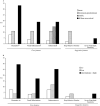Clinicopathological outline of dementia with Lewy bodies applying the revised criteria: the Hisayama study
- PMID: 18462473
- PMCID: PMC8095527
- DOI: 10.1111/j.1750-3639.2008.00169.x
Clinicopathological outline of dementia with Lewy bodies applying the revised criteria: the Hisayama study
Abstract
To explore the validity of the criteria for dementia with Lewy bodies (DLB) revised in 2005, we examined community based consecutive autopsy cases. 10.3% of the non-demented subjects and 31.2% of the demented subjects showed the Lewy body pathology. Applying the revised pathological criteria to the 205 demented subjects, the types of LB pathology of 11 cases (5.4%) were brainstem-predominant, 24 cases (11.7%) were limbic type and 24 cases (11.7%) were diffuse neocortical type, although there were many subjects not to fit the criteria exactly. The prevalence of Lewy bodies (LBs) was almost same regardless of gender; however, the extent of the LB pathology among females was more severe than that in males. The likelihood of DLB being modified by concomitant Alzheimer's pathology was as follows: 27 cases (13.2%) showed low likelihood, 16 cases (7.8%) showed intermediate likelihood and 16 cases (7.8%) showed high likelihood. Since the numbers of clinical features of DLB were significantly higher in the pathological intermediate and high likelihood DLB groups than in the low likelihood DLB group or no LB group, both the intermediate and high likelihood groups of DLB should be considered as pathological DLB.
Figures

References
-
- Anonymous (1997) Consensus recommendations for the postmortem diagnosis of Alzheimer's disease. The National Institute on Aging, and Reagan Institute Working Group on Diagnostic Criteria for the Neuropathological Assessment of Alzheimer's Disease. Neurobiol Aging 18(Suppl.4):S1–S2. - PubMed
-
- Anonymous (2001) Pathological correlates of late‐onset dementia in a multicentre, community‐based population in England and Wales. Neuropathology Group of the Medical Research Council Cognitive Function and Ageing Study (MRC CFAS). Lancet 357:169–175. - PubMed
-
- Association AP (1987) Diagnositic and Statistical Manual of Mental Disorders, 3rd edn., revised. American Psychiatric Association: Washington, DC.
-
- Ballard C, McKeith I, Burn D, Harrison R, O'Brien J, Lowery K et al (1997) The UPDRS scale as a means of identifying extrapyramidal signs in patients suffering from dementia with Lewy bodies. Acta Neurol Scand 96:366–371. - PubMed
Publication types
MeSH terms
LinkOut - more resources
Full Text Sources
Other Literature Sources
Medical

